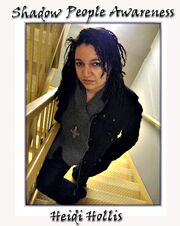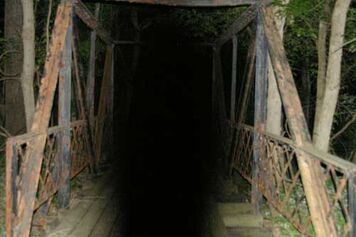

Shadow Person on Bridge.
Shadow people (also known as shadow ghosts, shadow figures, shadow beings, shadow men, or shadow folkTemplate:Or) are supernatural shadow-like humanoid figures that, according to believers, are seen mostly in peripheral vision and move quickly. They are sometimes known in modern folklore and paranormal popular culture as dark entities with malevolent intentions.[1] The title "Shadow People" was coin-phrased by Author and paranormal enthusiest, Heidi Hollis. Heidi first used the term in her book, "The Secret War". Heidi's claims to the Shadow People are that they are not of this world, it is to her knowledge; she believes them to be a race of alien life form. Heidi has been refered to as the "Shadow People Expert" by radio Host, George Noory of Coast to Coast.
Scientific explanations[]
Template:OriginalResearch Several scientific principles can be used to explain reports of shadow people, including optical illusions or hallucinations brought on by physiological/psychological circumstances, drug use or side effects of medication, and the interaction of external agents on the human body.Template:Citation needed
An illusion of a shadow person can be created when the left temporoparietal junction, a specific region of the brain, is stimulated. This sensation (the illusion of seeing a shadow person) may be heightened in people who have a psychotic disorder such as schizophrenia or paranoia. The brain uses sensory information such as figuring out where certain body parts are in relation to objects around the body. The temporoparietal junction deals with these cues too and when the function is disrupted, it is possible for the brain to perceive two bodies instead of one. [2]Template:Syn
Pareidolia can sometimes explain why figures are seen peripheral areas of vision. Pareidolia is a phenomenon in which the brain incorrectly interprets random patterns of light/shadow or texture as familiar patterns such as faces and human forms.[3]Template:Syn
Hypnagogia (also known as "waking-sleep"), a physiological condition in which one is partially between sleep and full consciousness, could also account for such perceptions.[4]Template:Syn During hypnagogia, one can be conscious and aware of their environment, but also in a dream-like state where they can perceive images from their subconscious. People experiencing hypnagogia commonly report seeing or sensing lights or shadows moving around them, as well as other visual hallucinations and even a (subtle or powerful) feeling of dread. Hypnagogia is sometimes known as 'the faces-in-the-dark phenomenon' because these people commonly report seeing faces while experiencing hypnagogia. Hypnagogia hallucinations are more common in people who already experience symptoms of insomnia, extreme daytime sleepiness, or mental disorders. However, these hallucinations are most common in people who are experiencing narcolepsy.[5]Template:Syn
Another reason that could be behind the illusion of seeing a shadow person is the symptoms sleep deprivation. Hallucinations have been connected with the deprivation of sleep. With lack of sleep, the neurons in the brain are unable to work efficiently and effectively. Therefore, the brain may create a picture dissimilar to reality and cause the person to believe in something that isn't there.[6]
Schizophrenia can provide another explanation for Shadow People. People who are often associated with this mental disorder can have delusions and see things that aren't actually there. Delusions can occur in the nonappearance of abnormal perceptions and different beliefs can be present in various people with abnormal perceptions. Schizophrenic people may have delusions that rise out of tendencies to attribute to the causes of outside forces. [7]
See also[]
- Apparitional experience
- Bhoot (ghost)
- Ethereal being
- Succubus
- Yurei
References[]
- ↑ Template:Cite book
- ↑ Template:Cite web
- ↑ Wiggins Arthur W. Wynn Charles M. (2001), "Quantum Leaps in the Wrong Direction : Where Real Science Ends...and Pseudoscience Begins," National Academies Press, ISBN 0-309-07309-X
- ↑ Ohayon M M, Priest RG, Caulet M, Guilleminault C (1996), Hypnagogic and hypnopompic hallucinations: pathological phenomena?, The British Journal of Psychiatry (October 2006)
- ↑ McKellar Peter (1957), "Imagination and thinking: A psychological analysis," ISBN B0007DES76
- ↑ Template:Cite web
- ↑ Chatterjee, Rhitu (September 20, 2006). "Illuminating the Shadow People". Science Now. http://news.sciencemag.org/sciencenow/2006/09/20-04.html. Retrieved 13 April 2010
id:Manusia bayangan ru:Люди-тени fi:Varjoihmiset sv:Skuggvarelser